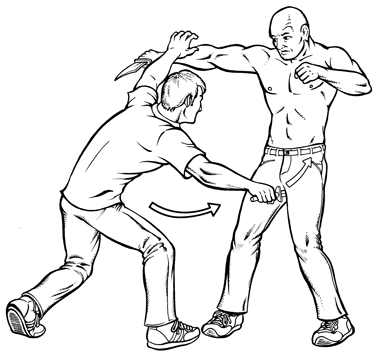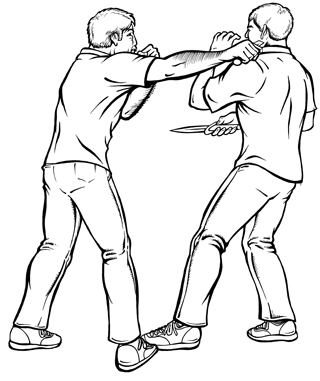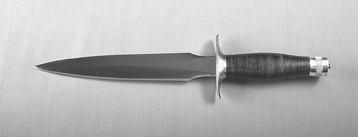Hank Reinhardt's Book of Knives: A Practical and Illustrated Guide to Knife Fighting (19 page)
Read Hank Reinhardt's Book of Knives: A Practical and Illustrated Guide to Knife Fighting Online
Authors: Hank Reinhardt

Because a dagger can cut in both directions, a missed cut can be redirected as a reverse slash.
The dagger adapts easily to tricky counter maneuvers. For one: as your opponents slices at you, bend over at the waist and let his blade go over the top. At the same instant stab upward into his groin or the inside of his thighs, hitting the testicles or the arteries on either side. This is an especially easy move if your opponent is taller. But timing is crucial and it takes a great deal of practice. I would suggest that when you practice your sparring partner wear an athletic cup. It is wise to save all our injuries for the real knife fight.

When you practice, your sparring partner should wear an athletic cup.
Another cut is a direct line thrust to the side of the head, right below the earlobe.

When properly executed, a direct line thrust to the side of the head, right below the earlobe, is effective.
You need to close with your opponent, make a sweep across his forearm, then make a direct line thrust, and step back out. This move presents a lot of exposure to you, but properly executed it gets the job done.
One big advantage of the dagger is that hand cuts can be delivered in almost any direction. If your blade is under your opponent’s hand, all you have to do is cut upwards. If you are above your opponent’s hand, a cut in almost any direction will make contact.
A dagger is one of the most difficult weapons to snatch from an opponent’s hand. With edges top and bottom it is almost impossible to grab the blade without being severely cut. Always be sure you blade is extremely sharp, and that the profile of your blade extremely thin. Your need a very sharp point, but not a thin one. It’s easy to see how this can be accomplished by looking at a Randall No. 2. It has enough weight to have cutting power but it is still light enough to make a fast, snapping cut, with a point that is strong yet sharp.

Randall No. 2, 12¾ inches overall length.
HRC618
In choosing a dagger shape, make sure that your choice fits this profile, you’ll have a dagger that can both cut and thrust. Extremely thin needle type points are not necessary on a modern fighting dagger. We are not worrying about piercing a mail shirt, or a doublet full of whalebone.
With a strong point design and a lot of distal taper, the ideal design can be moved with amazing speed. Quick straight-line thrusts even to the sternum have a good chance of penetration into the thoracic cavity and beyond. Also, snapping cuts like the Reinhardt Snap are easy with this design. Daggers may be out of style with some current notions of knife fighting, but you can have one of the best weapons ever designed in your hands.
10
YOU, THE KNIFEFIGHTER
MINDSET
Of all the weapons you may carry, the most powerful and versatile is your brain. And of all the attitudes one may carry, alertness is often most useful. Be alert to your surroundings at all times. You are especially vulnerable going in or out of your home or going to and from your vehicle. No one can be hot and ready to go twenty-four hours a day, seven days a week. But in times of heightened danger you need to kick it up a notch. Little things count—like when entering a building, locating the exits and observing the walls which might cover your rear should you suddenly face an encounter.
This is something difficult to teach, but if you have the habit of constant awareness you are less likely to be surprised and panicked by a sudden attack. Keep your hand unobtrusively on the knife in your pocket when going to and from your vehicle, or your house. Of course, alertness isn’t all of it by a long shot. To survive an encounter, you must develop a certain mindset which is even harder to teach—the will to survive and the determination to overcome. Hank discussed the warrior’s mindset in his book on swords.
But to summarize it here: Begin this process by paying attention to your looks. If a person looks like a victim, walks and talks like a victim, and carries a victim’s mindset, the kindest way to describe this person is what we lovingly call the “whining weenie.” He is usually the priority target of every mugger and thug in the neighborhood.
A friend of mine had a coworker who fitted this character perfectly. He was scared to death of his own shadow, and he asked my friend for ideas to protect himself. My friend suggested he buy a gun and learn to shoot it. His response was one of horror: “Oh, my God they’re expensive and make a lot of noise when you pull the trigger. The mugger will just take it away from you.”
My friend suggested he get some pepper spray instead. His response was equally stricken: “What if it doesn’t work and they beat me up?”
My friend then suggested he buy a knife and learn how to use it. His response: “My God, what if they take it away from me and stab me with it?” I think you are beginning to get my point. No amount of training or equipment will help this guy. He had short-circuited his strongest weapon, his brain. General George S. Patton, Jr. said it differently: “Do not take counsel of your fears.” If this is your attitude about defending yourself and your family, I guess you are just going to end up being a victim.
If a confident appearance and awareness of your surroundings still aren’t enough for you to avoid combat, there are other attitudes to cultivate. First, it is important to stay one step ahead of your opponent, no matter how deadly the encounter. Second, fix in your head the idea that you are going to win no matter what occurs.
Now that we have discussed your mental attitude, keep in mind one of the best ways to avoid trouble is to treat everybody just the way you would want to be treated. This is not a book about manners. But being a gentleman at all times will keep you out of a lot of trouble.
PHYSICAL TRAINING
Almost as important as the knife-fighter’s mindset is his physical training. If you are faster, stronger, and more durable than your opponent it is a definite plus. Sitting on a couch reading this book, while avoiding any physical exercise, can quickly put you on the casualty list. It is not necessary to buy a total gym and try to become the new Mr. America. One of the cheapest and simplest methods is to buy a set of five-pound hand weights. Begin by doing twenty-five curls with both arms. Then raise the weights to chest level, and do twenty-five jabs with the right hand and twenty-five jabs with the left. Take a five-minute break. Then and do fifty jabs with the left, fifty jabs with the right, followed by fifty curls with both hands.
After a ten-second break, do a hundred curls and a hundred jabs with both hands. Rest for another ten seconds, then repeat the process. Keep this up for thirty minutes. Do this every day. You will soon find your speed on the jab has improved greatly, and your arm strength has improved too. This simple exercise can be done almost anywhere, for only the cost of two inexpensive hand weights.
Now for a quick review: Choose your knife carefully. Beware of gimmicks. Practice your cutting on cardboard, free-hanging half-inch manila rope, and water-filled soda bottles. Practice the draw from your pocket until it is smooth and fast. Mesh your draw and cutting with proper footwork. Get on your weight routine and stick to it. Find a good group of sparring partners and practice often. And remember, have a winner’s mindset.
SHARPENING YOUR BLADE
In several of the chapters we have talked about the sharpness of your knife. In our first chapter we referred to shaving-sharp edges. This is self explanatory. You take the edge of the knife and put it on your arm at a 45-degree angle and push forward. The knife should shave hair from your arm. You need to be very careful when you do this. Go slow!
We have often referred to “book-cutting” sharpness of a knife. Just take a paperback book, lay it on a flat surface, and with your hand along the spine of the knife, you push down, rocking the edge left to right. If your blade is really sharp it should cut through the book with no trouble at all. Be careful. You can really cut the hell out of yourself.
We also talked about cutting free-hanging rope and water-filled soda cans or bottles. You should cut through the rope at a 45-degree angle and the bottles as well. Once again be very careful. To really cut well you need to practice often and keep all body parts well out of the way
If your knife is dull and won’t cut books or shave, you’ll need to sharpen it. Remember that sharpening is just the removal of metal. It doesn’t matter how you do it as long as you get results. One of the easiest ways to do this is to take a diamond hone or hard Arkansas stone and follow the bevel of your knife up and down. Once you run the stone down one side of the bevel, on the opposite side you will in time feel a “feather” or “burr.” Then repeat the process on the other side of the knife, and you’ll feel the same thing there. Now buff this feather off by stropping the blade back and forth on a buffing block. This block can easily be made by gluing a strip of leather to a block of wood. About five inches of a two-by-four works just fine.
What does this feather or burr look like? Often it is big enough to be seen by the naked eye. As you buff the blade on the block, look at the edge under magnification and you will see a little silver hair along the edge line. Once this hair is buffed off, you need to continue to buff until the edge is book-cutting sharp. This takes a great deal of practice, but once mastered it can be done with a diamond hone and the belt right off your pants,
This method requires no tools at all, no belt sanders, no buffing wheels. Occasionally buffing the edge of you knife between cuttings is the easiest way I know to keep your knife in top condition. Make a buffing block and remember to keep your edge sharp. All it requires is practice, lots of it. Don’t get frustrated. Like Mama’s cornbread, just keep doing it until you get it right.
EPILOGUE
THE TRUE SECRETS OF KNIFE FIGHTING
Hank Reinhardt was a true student of edged weapon combat, so much so that he traveled around the world seeking knowledge in this field. One of his trips took him to the roof of the world, tiny Nepal in the Himalaya Mountains, home of the Gurkhas and the kukri. On his return I asked him what he had discovered.
He told me he had traveled the dusty mountain roads to a small Nepalese village. One of the inhabitants there was a highly decorated Nepalese soldier who has used the kukri to good effect on many occasions in many battles. Hank met this pleasant gentleman on a cold, wind-swept pass and asked him if he would mind discussing his battle exploits.
The Hillman smiled and said he would be glad to recall the years he fought for the English king. Hank asked him, “How best do you use the kukri in combat?” The Nepalese answered back in a thick accent:
“It is best to use the edge of the kukri, because that is the part that cuts, sir.”
Hank nodded his head in agreement. “Now that we’ve established that you use the edge of the knife to cut with,” Hank asked, “how best do you use the edge of your kukri?” The Gurkha smiled and replied:
“You hit them with the edge very hard.”
Hank inquired further, “If you hit them with the edge and it does not work, what do you do then?” The small Hillman looked at Hank as though he had lost his mind and answered:
“You hit them again—harder.”
Hank then wanted to know if there were any other useful moves with the kukri in combat. The Nepalese replied with a grin:
“If you hit them with the edge and hit them hard, then that is all that is necessary.”
After Hank told me this on the telephone there was a brief moment of silence between both of us, and then I said to Hank, “Let me get this straight: I need to use the edge of my knife, because that is the sharp part. If that doesn’t work, then I hit them again—is that right?”
“Well, tiger, I guess that’s the way it goes,” Hank replied.
At this point we both broke out laughing. You see, there are no real secrets to fighting with knives. There are only good sharp edges, well-honed points, lots of practice with good sparring partners, and using your mind to beat your opponent. But then again, that’s the way we always knew it was. And you don’t have to go to the roof of the world to find it out.

Randall No. 2, 12¾ inches overall length.
HRC602
